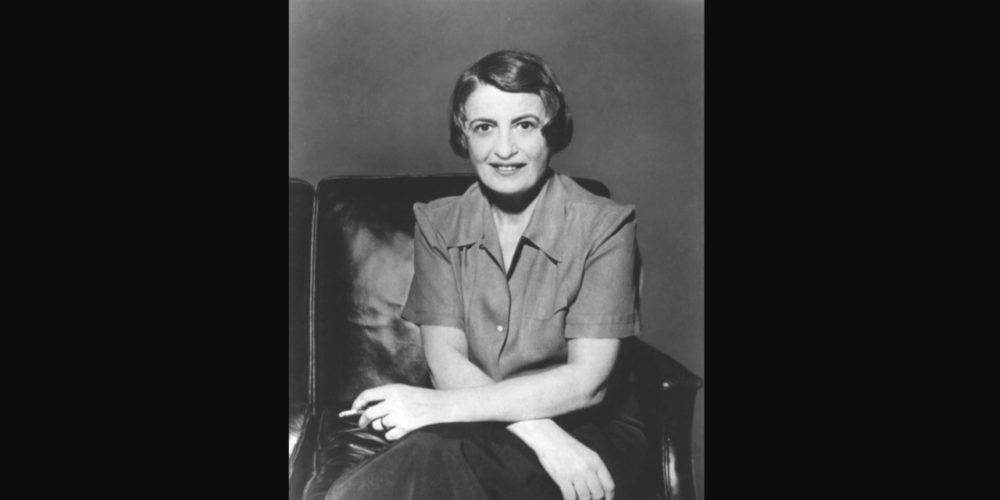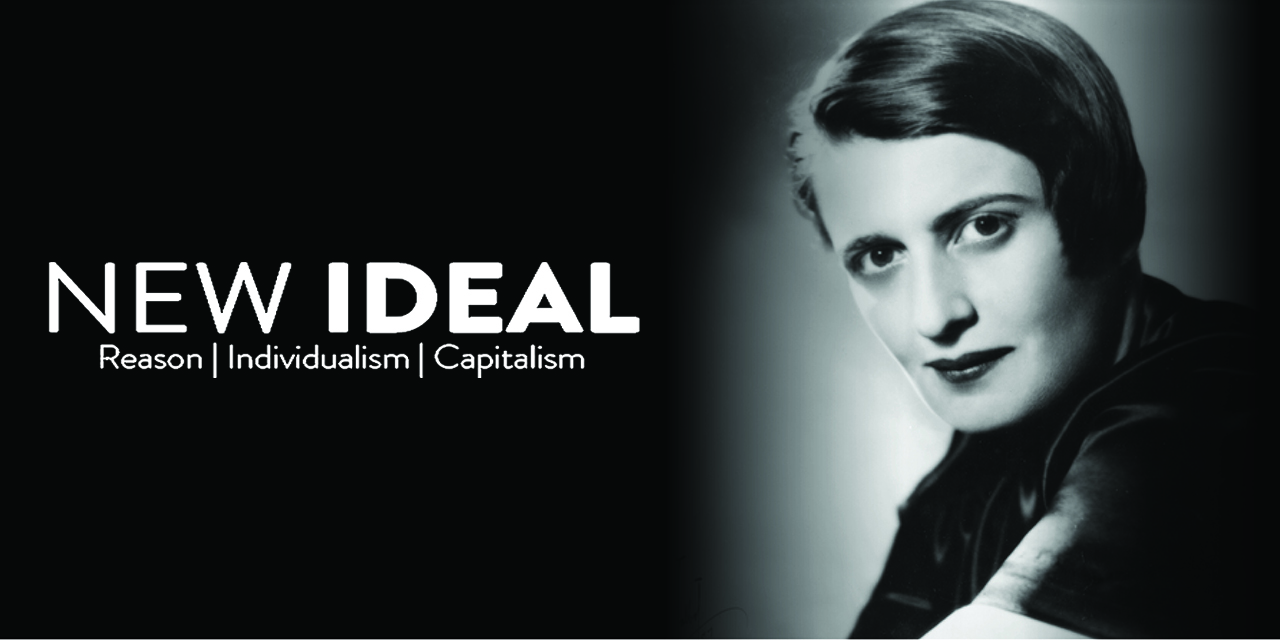Shortly after Ayn Rand’s death in March 1982, Harry Binswanger undertook the task of highlighting the historical significance of Rand’s philosophy, Objectivism. He did so by singling out six landmarks in her thought — “breakthroughs representing the major turning points in philosophy” — which, taken together, offered “a new view of the relationship of consciousness to existence.”
Originally published in The Objectivist Forum, June through December 1982, Binswanger’s article was written for an audience having a basic knowledge of Objectivism. It presents an essentialized view of what is new and important in the philosophy. (For a systematic presentation of Rand’s philosophy, see Leonard Peikoff’s 1991 book, Objectivism: The Philosophy of Ayn Rand.) Binswanger’s essay is a celebration of Rand’s philosophical discoveries, and we are delighted to republish it in its entirety in New Ideal, making it more readily available to a new generation of readers.
Ayn Rand’s Philosophic Achievement
By Harry Binswanger
Ayn Rand’s achievement in philosophy is so immense that to do it justice in an article would take an Ayn Rand.
From “existence exists” to a new definition of Romanticism in art; from the theory of universals to the nature of self-esteem; from the role of the mind in production to the esthetics of music; from the metaphysical status of sensory qualities to the need for objective law — like a philosophical Midas, any area she touched turned to knowledge. And all this from a novelist, a novelist who found that to define her concept of an ideal man she had to answer basic philosophical questions, and that each answer she reached confirmed, strengthened, and added to her previous answers, until she had formulated an invincible philosophic system.
That system, Objectivism, has many distinctions: its originality, its independence of philosophic tradition, its integration — but these aspects become irrelevant in light of what is most distinctive about Ayn Rand’s philosophy: it is true.
One of the greatest and rarest of philosophic achievements is to add a valid concept to the language. Ayn Rand left us a whole vocabulary. She formed new concepts — e.g., “psycho-epistemology,” “sense of life,” “concept-stealing.” She took traditional terms, gave them rational definitions, and transformed them into the solid girders of her intellectual structure — e.g., “reason,” “essence,” “selfishness,” “rights,” “art.” Then there were the floating abstractions, the package-deals, and the anti-concepts (three more of her terms) that she demolished — e.g., “duty,” “extremism,” “the public interest.”
Blasting away false alternatives, she drew her own distinctions in terms of essentials: “the primacy of existence vs. the primacy of consciousness,” “the intrinsic and the subjective vs. the objective,” “the metaphysical vs. the man-made,” “selfishness vs. sacrifice,” “errors of knowledge vs. breaches of morality,” “economic power vs. political power.”
In an age that scorns consistency and integration, Ayn Rand created a unified, hierarchically ordered system. Consider, for example, her definition of capitalism: “Capitalism is a social system based on the recognition of individual rights, including property rights, in which all property is privately owned.”1 Supporting that definition is a theory of individual rights: “A ‘right’ is a moral principle defining and sanctioning a man’s freedom of action in a social context.”2 Supporting that, in turn, is a theory of morality, of the nature of principles and their role in human life, of man’s nature, of freedom, and of society. And supporting each of these elements there are further principles — e.g., supporting her concept of freedom is the distinction between initiated and retaliatory physical force, the connection between voluntary action and free will, the relationship of free will to the law of causality, the basis of causality in the law of identity, and the relationship of the axiom of identity to the axiom of existence. Such is the power, and the glory, of Ayn Rand’s thought.
Words are the tools of thought. Today, when philosophers are staring blankly at these tools, while the best among them are trying to use saws as hammers and the average ones are “proving” that saws do not exist, Ayn Rand created the intellectual equivalents of the electron microscope and the computerized laser drill.
In the explosion of philosophical knowledge Ayn Rand produced, I would single out six landmarks — six breakthroughs representing the major turning points in philosophy:
- The primacy of existence
- The theory of concepts
- The theory of free will
- Man’s Life as the standard of morality
- The moral basis of individual rights
- The psycho-epistemology of art.
Unlike most philosophers, Ayn Rand was explicit about the starting point of her philosophy: the fact that “existence exists.”
“Existence exists — and the act of grasping that statement implies two corollary axioms: that something exists which one perceives and that one exists possessing consciousness, consciousness being the faculty of perceiving that which exists.”3
Ayn Rand was not the first philosopher to identify or uphold the fact of existence (that honor goes to the pre-Socratic philosopher Parmenides). But she was the first to recognize the relationship of consciousness to existence — i.e., that existence is the primary axiom of all knowledge and that consciousness can neither exist nor be identified except in relation to existence. As important as her immortal phrase “existence exists” is the simple clause at the end of the sentence, “consciousness being the faculty of perceiving that which exists.” Together they form the basis of the principle Ayn Rand named “the primacy of existence,” and which she contrasted to the fundamental error in every major system of the last three hundred years: “the primacy of consciousness.”
Descartes’ famous phrase “I think, therefore I am” marked the reversal which ripped all subsequent philosophy away from reality and from the actual problems of man’s life. Descartes was proposing, in effect, that one could know that one exists possessing consciousness prior to and independent of knowing that existence exists. But, to continue the passage from Galt’s Speech: “If nothing exists, there can be no consciousness: a consciousness with nothing to be conscious of is a contradiction in terms.” This contradiction cannot be eluded by maintaining that what one is conscious of might always be the states or contents of one’s own consciousness. For, as Ayn Rand’s next sentence demonstrates, this merely pushes the same contradiction back one level: one’s own consciousness — of what? “A consciousness conscious of nothing but itself is a contradiction in terms: before it could identify itself as consciousness, it had to be conscious of something.”
Consciousness must precede self-consciousness. Ultimately, then, either man is conscious of reality, or he is not conscious. “If that which you claim to perceive does not exist, what you possess is not consciousness.”
And there you have the genius of Ayn Rand: a new foundation for philosophy, wiping out three centuries of error, contained in four sentences delivered by her fictional hero at the climax of the greatest novel in literature.
* * *
The primacy of existence provides the basis for Ayn Rand’s discoveries concerning the specifically human level of consciousness, the conceptual level, the level of reason.
“I am not primarily an advocate of capitalism,” she wrote, “but of egoism; and I am not primarily an advocate of egoism, but of reason. If one recognizes the supremacy of reason and applies it consistently, all the rest follows.”4 To summarize Ayn Rand’s view of reason is to summarize Objectivism.
Reason involves three factors: the senses, logic, and concepts. The metaphysical basis of logic (and the rules of deduction) was identified by Aristotle. The validity of the senses was established by Aristotle, elaborated by Thomas Aquinas, and fully clarified by Ayn Rand. But in the absence of an objective theory of concepts, the relation of reason to reality remained problematic. Until the “problem of universals” could be solved, reason lay vulnerable to the tricks and sophistries that centuries of mind-hating philosophers used against it. To defend reason and to understand it properly, this was the problem that had to be solved.
The challenge was perhaps best formulated by Antisthenes, a philosopher of Ancient Greece. In objection to someone who was discussing the nature of man, Antisthenes was reported to have said: “I have seen many men, but never have I seen man.” Neither Plato, nor Aristotle, nor any philosopher in the twenty-four centuries since Antisthenes, was able to answer him. The Aristotelians, for instance, held that the concept of “man” refers to the “manness” in men. But Antisthenes’ objection can then be re-stated: “I have seen many attributes of men, but never have I seen manness.” Other philosophers, such as Locke, suggested that “manness” refers to the characteristics that we do perceive in men: their shape, their color, their height, etc. But, again, these characteristics are always particular, never universal.
“To exemplify the issue as it is usually presented: When we refer to three persons as ‘men,’ what do we designate by that term? The three persons are three individuals who differ in every particular respect and may not possess a single identical characteristic (not even their fingerprints). If you list all their particular characteristics, you will not find one representing ‘manness.’ Where is the ‘manness’ in men? What, in reality, corresponds to the concept ‘man’ in our mind?”5
Ayn Rand’s solution to this problem cannot be presented briefly (her full presentation is given in Introduction to Objectivist Epistemology). But the key idea behind her solution is that concepts are based on observed similarities and differences, and that “similarity, in this context, is the relationship between two or more existents which possess the same characteristic(s), but in different measure or degree.”6
The basis of concepts does not lie in any intrinsic “universal”; “manness” is not an element existing in men. But the metaphysical basis of concepts does lie in a fact of reality, the fact that similar concretes differ only quantitatively — only in their measurements. “The process of concept-formation consists of mentally isolating two or more existents by means of their distinguishing characteristic, and retaining this characteristic while omitting their particular measurements — on the principle that these measurements must exist in some quantity, but may exist in any quantity.”7
Thus Antisthenes’ objection is entirely misplaced. It assumes, as did the defenders of reason, that concepts are simply high-class percepts. But, in fact, “The relationship of concepts to their constituent particulars is the same as the relationship of algebraic symbols to numbers. In the equation 2a = a + a, any number may be substituted for the symbol ‘a’ without affecting the truth of the equation. For instance: 2 x 5 = 5 + 5, or: 2 x 5,000,000 = 5,000,000 + 5,000,000. In the same manner, by the same psycho-epistemological method, a concept is used as an algebraic symbol that stands for any of the arithmetical sequence of units it subsumes. Let those who attempt to invalidate concepts by declaring that they cannot find ‘manness’ in men, try to invalidate algebra by declaring that they cannot find ‘a-ness’ in 5 or in 5,000,000.”8
The foregoing is the basis of Ayn Rand’s defense of reason in epistemology; equally important is her view concerning the role of reason in human existence. The starting point here is another of Miss Rand’s major discoveries, one that stands at the center of her view of man: reason is volitional.
“That which you call ‘free will’ is your mind’s freedom to think or not, the only will you have, your only freedom, the choice that controls all the choices you make and determines your life and your character.”9 There are two points here: 1) man’s choice to exercise his rational faculty is not necessitated by any prior cause, and 2) reason is the prime mover in man’s life: the other aspects of his existence — his ideas, values, actions, and emotions — depend upon the extent to which he is rational or irrational.
The latter point involves one of Ayn Rand’s most important identifications: “your emotions are the products of the premises held by your mind.”10 The belief that emotions are irreducible primaries at war with one’s rational judgment is a major source of the mystics’ mind-body dichotomy (see, for example, Plato’s Republic.11) By showing that one’s emotions result from one’s premises, and that these premises are the automatized products of one’s use (or misuse) of reason, Ayn Rand knocked a major prop out from under the mind-body dichotomy. “An emotion that clashes with your reason, an emotion that you cannot explain or control, is only the carcass of that stale thinking which you forbade your mind to revise.”12
Building upon the work of Aristotle, Ayn Rand’s concept of reason as the fundamental of man’s nature underlies her defense of man as an integrated being of mind and body, whose reason and emotion can be in perfect accord. “There is no necessary clash, no dichotomy between man’s reason and his emotions — provided he observes their proper relationship. A rational man knows — or makes it a point to discover — the source of his emotions, the basic premises from which they come; if his premises are wrong, he corrects them. . . . His emotions are not his enemies, they are his means of enjoying life. But they are not his guide; the guide is his mind.”13
Ayn Rand went on to explain the basic psychological form in which man confronts the choice to think or not: the choice to focus his mind or not. “Thinking requires a state of full, focused awareness. The act of focusing one’s consciousness is volitional. Man can focus his mind to a full, active, purposefully directed awareness of reality — or he can unfocus it and let himself drift in a semiconscious daze, merely reacting to any chance stimulus of the immediate moment, at the mercy of his undirected sensory-perceptual mechanism and of any random, associational connections it might happen to make.”14
Consider the significance of this discovery: it gives man conscious control over that which controls his life. Although every normal adult knows how to focus his mind, no one, until Ayn Rand, had grasped explicitly that that was what he was doing, that it is his basic choice, and that its significance is life or death. As with the fact that existence exists, men were aware of mental focus implicitly, but: “That which is merely implicit is not in men’s conscious control; they can lose it . . . without knowing what it is that they are losing or when or why.”15
Ayn Rand saw man as a heroic being. Her theory of free will makes that view of man possible. The concept of “heroism” would be inapplicable to a being whose mind was run by forces beyond his control. A robot cannot be heroic. Only a being who can exercise rational control over his character and actions is capable of heroism. Only “a being of self-made soul” is capable of self-esteem.
The link between Ayn Rand’s view of reason and her ethics, politics, and esthetics is the fact that reason is man’s means of survival. The key to all the rest of Objectivism is one connection: in order to survive, man must choose to think.
“Man cannot survive, as animals do, by the guidance of mere percepts. A sensation of hunger will tell him that he needs food (if he has learned to identify it as ‘hunger’), but it will not tell him how to obtain his food and it will not tell him what food is good for him or poisonous. He cannot provide for his simplest physical needs without a process of thought. . . . No percepts and no ‘instincts’ will tell him how to light a fire, how to weave cloth, how to forge tools, how to produce an electric light bulb or an electronic tube or a cyclotron or a box of matches. Yet his life depends on such knowledge — and only a volitional act of his consciousness, a process of thought, can provide it.”16
This leads directly to the basis of morality. Morality “is a code of values to guide man’s choices and actions — the choices and actions that determine the purpose and the course of his life.”17
End of Part 1. Part 2 is here.
This article originally appeared in The Objectivist Forum, a bimonthly journal of ideas edited and published by Harry Binswanger, between June and December 1982. Copyright © 1982 by TOF Publications, Inc.; republished by permission.
SUPPORT ARI: If you value the ideas presented here, please become an ARI Member today.
Readers seeking a superior print result may wish to download the free Just Read app.
Do you have a comment or question?
Endnotes
- Capitalism: The Unknown Ideal (Signet: 1967), p. 19.
- Ibid, p. 321.
- Atlas Shrugged (Signet: 1957), p. 942.
- “Brief Summary,” The Objectivist, Sept., 1971, p. 1.
- Introduction to Objectivist Epistemology (Mentor: 1979), p. 2.
- Ibid., pp. 15–16.
- Ibid., pp. 111–12.
- Ibid., pp. 22–23.
- Atlas Shrugged, pp. 943–44.
- Ibid., pp. 946–47.
- Republic, Bk. IV, 434–41.
- Atlas Shrugged, p. 962.
- “Playboy’s Interview with Ayn Rand,” p. 6.
- The Virtue of Selfishness (Signet: 1966), p. 21.
- For the New Intellectual (Random House: 1961), p. 62.
- The Virtue of Selfishness, p. 21.
- Ibid., p. 13.







